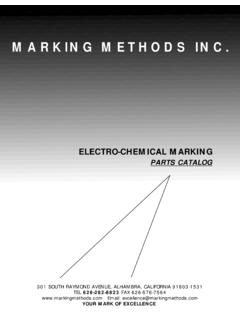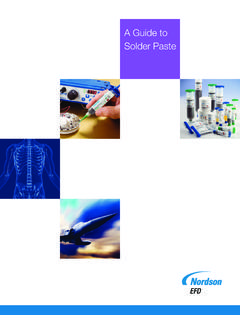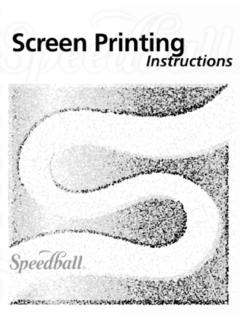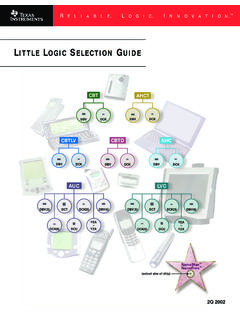Transcription of Electroplating - The Institute of Materials Finishing
1 Electroplating A guide for designers and engineers Prepared for the Committee for the Promotion of Electroplating by Joseph Edwards The Committee for the Promotion of Electroplating is sponsored by the Institute of Metal Finishing , the British Metal Finishing Suppliers Association and the Metal Finishing Association, and comprises representatives of these bodies, and of Inco Europe Limited and the Zinc Development Association. For further information please refer to: The Committee for the Promotion of Electroplating c/o The Institute of Metal Finishing , Exeter House, 48 Holloway Head, Birmingham B11NQ Telephone 021-622 7387 Copyright Committee for Promotion of Electroplating 1983 Printed in UK April 1983 Foreword The UK plating industry - in common with that of most other countries - is highly fragmented, and therefore lacks the concerted marketing and industry development so effectively practiced by the paint and galvanizing industries.
2 This Guide is a further step by the Committee for the Promotion of Electroplating in bridging the information gap between the plating industry and the engineering and production management of the manufacturing industry. Today, electrodeposition technology offers the engineer the capability of providing specific surface properties, such as wear resistance, lubricity, hardness, solderability, electrical conductivity, corrosion resistance onto constructional metals or plastics which in turn satisfy the need for particular mechanical design needs. In these applications, the deposition of surface films is almost always cost effective and highly efficient; technology well suited to society's thrust for energy and material conservation. CPE hopes that this Guide will enable the discerning engineer to think in broader design concepts than perhaps hitherto, and that through electrodeposition technology, industry can more effectively accept the challenge of the eighties.
3 David Hemsley CHAIRMAN Committee for the Promotion of Electroplating . Committee Members March 1983 Hemsley, Chairman British Metal Finishing Suppliers Association Thomason, Treasurer British Metal Finishing Suppliers Association Arnull Inca Europe Limited Ashton Metal Finishing Association J. Metal Finishing Association. Poeton Metal Finishing Association R. H. Pinner Institute of Metal Finishing F. C. Porter Zinc Development Association Vivian Institute of Metal FinishingContents 1. The uses of Electroplating 1 Decoration 1 Corrosion protection 9 Engineering applications 15 Electrical applications 23 Electroforming 25 2.
4 The nature of the Electroplating process 27 Electrode reactions 27 Current and coating thickness distribution 29 General considerations 33 3. Design for Electroplating 35 Cost factors 35 Good and bad design 37 Types of plant 43 Plating processes 49 Preparation for plating 53 4.
5 Specifying and purchasing Electroplating 59 Requirements of customer and supplier 59 Pricing 61 Conditions of quotation and sale 63 5. Sources of further information 65 Books 65 Journals 67 Standards 69 Introduction Surfaces are not always given their proper due. In the design of manufactured goods and engineering components, they may come low in the order of priority. To allow this to happen could be a serious miscalculation. The surface of any article is the interface with its surroundings.
6 It determines its response to chemical and physical circumstances, its resistance to corrosion and tarnishing, its tolerance of impact and abrasion, its frictional and contact behaviour. It is what the consumer sees and touches, and so it contributes positively, or otherwise, to his satisfaction, both when the article is new and when it is well into its expected lifespan. Unless the immediate environment is controlled, there are surprisingly few applications in which homogenous Materials give an adequate account of themselves. The obvious resort is to coatings, which enable the bulk properties of one material to be combined with the surface properties of another. Many types of coating are employed. Organic finishes account for the greatest coverage. Conversion coating procedures are widely used: one, phosphating, is mainly a preparative treatment for painting, while another, anodising, is a Finishing process in its own right.
7 Metal coatings are applied by hot dipping, spraying, cladding, chemical and physical deposition methods. There is currently a great deal of interest in advanced physical techniques, such as ion plating and ion implantation, and these are likely to make great headway in specialized applications. But the group of processes offering the greatest diversity of properties and applications is that with which this guide is concerned: Electroplating . Electroplating is well established but not very well known. Unlike painting (some kinds, anyway), it is hardly a domestic art. Its apparent difficulty and complexity may obstruct its wider utilization. The object of this guide is to penetrate the aura of mystery surrounding Electroplating , as a step towards procuring its full industrial potential. It is directed principally at those concerned in the design and specification of manufactured metal products.
8 The sequence followed is to summarise existing applications as an illustration of the usefulness of electroplated coatings; to outline the fundamentals of Electroplating ; to review the factors to be borne in mind in designing articles to be electroplated and the relevant characteristics of individual basis Materials and plating processes; and to give some guidance on commercial matters. A list is included of useful sources of further information. Grateful acknowledgement is made to all the many people who assisted in the preparation and production of this guide. Historical note Shortly after Volta had invented the first battery, the so-called voltaic pile, one of his colleagues, Brugnatelli, used it as a source of current to electrodeposit gold on two silver medals, thus becoming the world's first electroplater. The year was 1803.
9 Not unusually, the innovation was slow to develop. Only a few plated articles survive from the early years of the nineteenth century, but there is a famous one in the Royal Collection at Windsor Castle: a gilt silver cup, made by Storr in 1814 and known as the Galvanic Goblet. A further quarter-century passed before the Elkington cousins established the Electroplating of silver and gold on an industrial scale in 1839. Meanwhile, Faraday had defined the first and second laws of electrolysis in 1833-4 and Daniell, in 1836, had developed the cell named after him, a much more reliable source of current than had existed before. The Elkingtons installed Daniell cells in their first plating shop; however, when Woolrich's Electro-magnetic Machine (based on Faraday's discovery of electro-magnetic induction) became available in 1845, they were quick to take it up.
10 Nickel plating was first performed by Bird in 1837, but it was not until 1868 that Adams, having made many improvements, was able to put the process into commercial operation. Zinc and copper electrodeposition were developed over the same period. There was a long gap, however, before chromium plating emerged, by a tortuous process in which many people were involved (Sargent, Fink, Schwartz, Udy and Liebreich), during the decade of the 1920' s. Page 1 1. The uses of Electroplating Decoration Chrome plate The most familiar of all electroplated coatings is chrome plate, not as common as it used to be on cars, but usual still on bicycles, domestic goods and fittings, hospital equipment, tubular furniture and wire goods, as well as many fasteners and other small items. (Figures 1 and 2.) The surface is usually bright, but satin and black finishes are also available.









